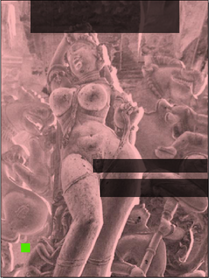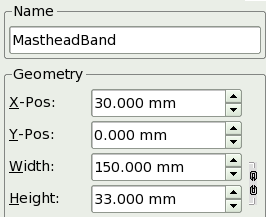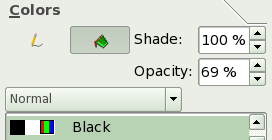Prise en main de Scribus:4
Prise en main de Scribus
| ||||||||
Chapter 4
|
- Ce que vous pouvez faire avec Scribus
- Scribus et ses frères
- Vide et réserves
- Page de couverture
- Travailler avec des calques
- Design Multiple Pages
- Create Final Page Layouts
- Design With Graphics And
Freedom - Set Fire With SVG Graphics
- Publishing Demands Freedom.PDF.
- Travel At The Speed Of Scribus
- Contributors
- GNU Free Documentation Licence
Page de couverture
Si vous voyez trop e guides sur votre page blanche, désactivez Affichage/Afficher les repères. Vous verrez les lignes bleues marquant les marges de la page. Le concept de base de Scribus est assez simple : Pour mettre une photo sur la page, vous devez d'abord créer un cadre d'image et importer la photo dedans. De la même façon, Pour placer du texte sur la page, vous devez d'abord créer un cadre de texte, y insérer, taper le texte. Vous découvrirez bientôt que cette approche comporte de nombreux avantages.
Insérer une image
Une toolbar contient tous les outils que Scribus met à votre disposition. Vous pouvez utiliser ce lien, mais souvenez-vous qu'en déplaçant votre souris sur les icônes, leur description apparaît. Cliquez sur le troisième (Insérer un cadre d'image ![]() )[Raccourcis: I]. Il vous permet d'insérer un cadre d'image dans la page. C'est ce dont vous avez besoin pour placer une image de couverture à l'endroit souhaité. Déplacez votre souris du coin supérieur gauche au coin inférieur droit. Ne vous inquiétez pas si vous n'êtes pas parfaitement placés. l'essentiel est de trouver le cadre d'image sur la page, avec sa forme rectangulaire avec ses grandes diagonales noires produisant un X. C'est une façon traditionnelle, dans l'industrie graphique, de différencier les cadres d'images des cadres de texte. Ce 'X' ne s'imprimera pas, pas de souci.
)[Raccourcis: I]. Il vous permet d'insérer un cadre d'image dans la page. C'est ce dont vous avez besoin pour placer une image de couverture à l'endroit souhaité. Déplacez votre souris du coin supérieur gauche au coin inférieur droit. Ne vous inquiétez pas si vous n'êtes pas parfaitement placés. l'essentiel est de trouver le cadre d'image sur la page, avec sa forme rectangulaire avec ses grandes diagonales noires produisant un X. C'est une façon traditionnelle, dans l'industrie graphique, de différencier les cadres d'images des cadres de texte. Ce 'X' ne s'imprimera pas, pas de souci.
L'esprit de Scribus
Dans les menus, Allez à Outils > Propriétés (dans 1.3.x Fenêtres > Propriétés). la fenêtre la plus importante de Scribus apparaît alors. Tous les objets que vous ajouterez à la page, des cadres d'images au cadres de texte en passant par les photos, lignes... sont contrôlés à partir de cette dernière. Assurez-vous que le cadre créé soit en surbrillance ou selectionné. Habituellement, des petits points rouge parqueront chaque angle. Si ce n'est pas le cas, dans la Boite à outils, cliquez sur la première icône ![]() (Selectionner des objets), et cliquez simplement sur le cadre d'image. La fenêtre propriétés va immédiatement afficher ses détails. Aussi, un objet doit-il être sélectionné pour être modifié ou supprimé.
(Selectionner des objets), et cliquez simplement sur le cadre d'image. La fenêtre propriétés va immédiatement afficher ses détails. Aussi, un objet doit-il être sélectionné pour être modifié ou supprimé.
Donnez un nom lisible à ce cadre, comme 'cadreCouverture' en remplissant le champ 'Nom' de la fenêtre. Dans le cas où vous ne verriez pas ce champ, cliquez sur l'onglet supérieur nommé X,Y,Z. Ensuite, vous trouverez ce champ tout en haut de la fenêtre. En X et Y, écrivez 0mm. Ecrivez aussi les largeurs et hauteurs à 210 mm et 280 mm respectivement. Votre cadre est à présent parfaitement placé dans la page. Vosu pouvez le repositionner et le redimensionner avec la souris, mais l'écriture des valeurs est plus précis et plus rapide à la fois.
Get Picture
After you make sure your image frame is selected, then right-click anywhere inside this image frame. You will see a Context Menu pop-up right under the mouse cursor. Select Get Picture... from this menu (in 1.3.x this is Get Image). A file dialog box opens up for you to navigate into your FYug folder, and then into the images folder, so you can select the 'TitleFX.jpg' sample image. Click on the OK button. The image frame on your Scribus page is immediately filled with the TitleFX.jpg image.
Nudge Picture to Left
Note the sculpture in the image is too much to the right. We must drag the picture inside the image frame to the left, so that the sculpture is positioned in the centre of the image frame. Extra parts of the picture will get automatically cropped out of view beyond the boundaries of the image frame. First, let's play with this positioning with the mouse. On the toolbar, click on the icon for Edit Contents of Frame ![]() .
.
Now when you left click inside the image frame you can manually slide your picture around, and for some projects this may be accurate enough. For our project let's be very precise. First, make sure the image frame is selected (click Select Item on the toolbar then click your frame again, or try this: left-click outside your frame and you will see the Select Item icon become highlighted, then left-click inside the frame to select it). Now go back to the Properties Tool and click on the tab titled 'Image'. In the field marked X-Pos, just type in the value “-90mm” to move the image 90 mm to the left. Note how the image is shifted inside the image frame.
Color Karma
At the bottom of the Properties Tool (Image tab), you may have noticed a section called 'Input Profiles.' This will only show if the LittleCMS on your PC is correctly installed and configured. The color of your images may look markedly different on your screen, and even more when you print them. This little area minimizes such color mismatch. From the pop-up for 'Input Profile', choose a color profile that closely matches your monitor. Scribus immediately re-renders the image on the screen to display colors according to that profile.
The actual installation of LittleCMS and how to use it under Scribus is actually quite simple, but beyond the scope of this tutorial. Here are some good tips:
- Download a set of free profiles from the Adobe site, so you can send images between Mac, Windows, and Linux.
- Create a custom color profile of your own monitor and use that instead of any other.
Save
You may want to save your file before proceeding. So head over to File>Save and type the name 'Fyug.sla' for your file. Save it in the FYug folder. You can also just click on the floppy icon in the taskbar, right underneath the menus, to save your file.![]()
Masthead Band
The cover page of any magazine has its name emblazoned across the top. This is called the Masthead. Ours is titled “FreedomYug.” We'll start by creating a semi-transparent band for the Masthead. Go to Settings > Preferences > Display (in 1.3.x File > Preferences > PDF Export). Make sure this checked: “Use PDF1.4 Transparency Features” (In 1.3.x make sure the PDF 1.4 is chosen under Compatibility). Click OK. Your document now supports transparent objects.
Click the fifth tool ![]() in the Toolbar. Should you hover your mouse over this, the roll-over text would display “Draw Various Shapes” or something similar. Select the rectangle shape from the drop-down menu. Click anywhere near the top-centre of the page and draw a rectangle. Make sure the rectangle is selected, and immediately go to the Properties Tool, click on the X,Y,Z tab, and enter the following values: X-Pos: 30mm. Y-Pos: 0mm. Width: 150mm. Height: 33mm. Give it a name, such as 'MastheadBand' in the Name field.
in the Toolbar. Should you hover your mouse over this, the roll-over text would display “Draw Various Shapes” or something similar. Select the rectangle shape from the drop-down menu. Click anywhere near the top-centre of the page and draw a rectangle. Make sure the rectangle is selected, and immediately go to the Properties Tool, click on the X,Y,Z tab, and enter the following values: X-Pos: 30mm. Y-Pos: 0mm. Width: 150mm. Height: 33mm. Give it a name, such as 'MastheadBand' in the Name field.
Then click on the Colors tab in Properties. Click the Pencil tool ![]() to select the stroke or outline border. Click on 'None' in the colors list. Then, click the bucket icon to select the fill color. Click on 'Black' from the list of colors, and in the opacity field, enter 69% (if you do not see an Opacity field, you have not selected PDF 1.4 transparency features -- see first paragraph above in this section). You will see the band has turned semi-transparent, and partly shows the image through itself, in darkened colors. Experiment with Opacity and other colors to your taste.
to select the stroke or outline border. Click on 'None' in the colors list. Then, click the bucket icon to select the fill color. Click on 'Black' from the list of colors, and in the opacity field, enter 69% (if you do not see an Opacity field, you have not selected PDF 1.4 transparency features -- see first paragraph above in this section). You will see the band has turned semi-transparent, and partly shows the image through itself, in darkened colors. Experiment with Opacity and other colors to your taste.
Add More Bands
Draw another rectangle towards the centre of the image. In the Properties Tool (X,Y,Z), give X-Pos: 93mm. Y-Pos: 160mm. Width: 115.35mm. Height: 13.75mm. Again in Colors, set the stroke to 'None', and the fill with 'Black' at an opacity of 69%. Call this the 'HeadlineBand'. A third rectangle, named 'SubHeadBand' can be drawn slightly underneath this, at X-Pos: 100mm. y-Pos: 180mm. Width: 109.7mm. Height: 18.35mm. The fourth and final rectangle, this time a little square box, will have the following Properties: X-Pos: 20.5mm. Y-Pos: 245mm. Width and Height will both be 9mm.
| Here is a shortcut you might try for a repetitive job like this. Instead of making each rectangle from scratch, then changing all of these parameters, after you make the first one and adjust its colors, just copy it: Item > Duplicate. Then all you have to adjust is its name, position, and size. |
Create Colors
| Hold on! Don't fill this with the same 69% Black. Let's give it a fresh lime green color. Go to Edit > Colors... in the menu. A dialog box listing existing colors displays on your screen. Click on 'New' and give your new color swatch a name, 'Lime Green' (if you already have a LimeGreen, call it LimeGreen2 or something else). In the second dialog-box that opens up, choose 'CMYK' as the Color Model. This closely follows the inks of Cyan, Magenta, Yellow, and Black, used in your desktop printer and in printing plants, that mix inks to create new colors. With the sliders at the bottom, give C:69%, M: 10%, Y:100%, and K: 0%.
Click OK in this dialog box, and then click OK again in the Colors dialog box, where you'll notice your new color added. Go back to your page, click on the small square you just created, and in the Colors tab of Properties Tool, give it a stroke of None, and a fill of LimeGreen, at 100% opacity. You cover should look like the screenshot here, with all the bands for text. |

|
Locked Bands
One last thing. Select each semi-transparant band individually, and in the Properties palette, in the X,Y,Z tab, click on the icon of the padlock ![]() at the bottom. This ensures you accidentally do not move or resize each locked object.
at the bottom. This ensures you accidentally do not move or resize each locked object.
Similarly, lock the CoverPicture Frame as well, and the green square, using this padlock. Also, uncheck 'Text Flows Around Frame' in the Shape tab of the Properties Tool for each of these rectangles. This allows text to overlap the rectangles.




